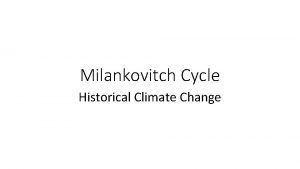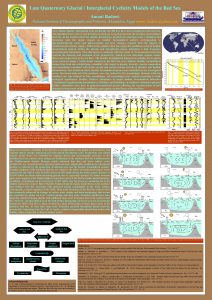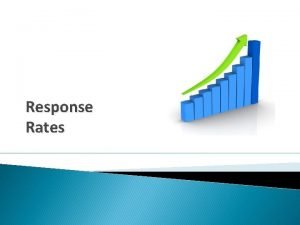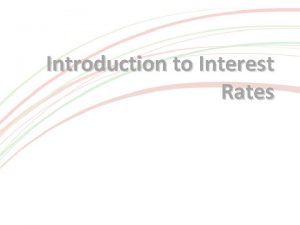A Last Interglacial perspective on future rates of












- Slides: 12

A Last Interglacial perspective on future rates of sealevel rise EGU 2020 -1513 session CR 1. 2 Eelco J. Rohling Fiona D. Hibbert* Research School of Earth Sciences The Australian National University eelco. rohling@anu. edu. au *Now at University of York, UK.

Intra-LIG variability First stratigr. continuous records (Red Sea) suggest fast rates. Rohling et al. , Nature Geoscience 1, 2008 Global statistical assessments • Total LIG range 6 -9 m above present • Suggest AIS first, Gr. IS later. Kopp et al. , Nature 462, 2009 2

Intra-LIG variability Although stratigraphically continuous, Red Sea record had drawbacks to be resolved: • Replication remained limited • Dating remained poor (also in statistical LIG assessments) • Stratigraphic reef architecture studies supportive, but altered, and thus not precisely datable. Rohling et al. , 2008 Nature Geocience 3

This talk (Nature Comms. , in review) 1. New age control point for end LIG in Red Sea RSL stack (onset previously constrained: Grant et al. , 2012 Nature; Marino et al. , 2015 Nature). 2. LIG signal exactly replicated from a distant core. 3. Probabilistic analysis of Red Sea record. 4. Compare with reef data, incl. stratigraphic evidence for intra-LIG variability. 5. Compare with Greenland (Gr. IS) sea-level contribution reconstructions. 6. Use Total−Gr. IS to determine Antarctic (AIS) contributions 4

1. Adjusting the LIG chronology in the Red Sea record Hibbert et al. (2016 QSR) Cutler et al. (2003 EPSL) Compare entire Red Sea RSL stack (red) with coral and Yucatan speleothem “ceiling” data: • Move end of LIG highstand in Red Sea record (@ 95% probability) from 123 to 118. 5 ka • Then straightforward non-linear, monotonic Hermite function interpolation (with Monte. Carlo-style uncertainty propagation) between existing control at 130 ka and new LIG-end control at 118. 5 ka. 5

2. Replicating the Red Sea record • Yau et al (2016 PNAS) Greenland sea-level contribution (blue). • New East Greenland current δ 18 Osw (black; 1. 3 ppm = 4 +/- 1 m). • LIG duration from corals (as previous slide) • Red Sea RSL & Yucatan speleothem RSL “ceilling” • CO 2 (blue) • Antarctic temperature change (red) • N Atlantic temperature (black) • Single-core Red Sea RSL core KL 11 (blue) • Single-core Red Sea RSL core KL 23 (red) • Validation of peak in KL 23 (black) • N Red Sea reef architecture (magenta) • Seychelles+Bahamas reef architecture (blue) • Probabilistic evaluation KL 11 record (black) 6

3. Probabilistic analysis of RS record with all its uncertainties (incl. stratigraphic constraints) 95% RSL uncertainties +/- 2 m • Yau et al (2016 PNAS) Greenland sea-level contribution (blue). • New East Greenland current δ 18 Osw(black; 1. 3 ppm = 4 +/- 1 m). • LIG duration from corals (as previous slide) • Red Sea RSL & Yucatan speleothem RSL “ceilling” • CO 2 (blue) • Antarctic temperature change (red) • N Atlantic temperature (black) • Single-core Red Sea RSL core KL 11 (blue) • Single-core Red Sea RSL core KL 23 (red) • Validation of peak in KL 23 (black) • N Red Sea reef architecture (magenta) • Seychelles+Bahamas reef architecture (blue) • Probabilistic evaluation KL 11 record (black) 7

4. Comparison with stratigraphic reef records • Yau et al (2016 PNAS) Greenland sea-level contribution (blue). • New East Greenland current δ 18 Osw(black; 1. 3 ppm = 4 +/- 1 m). • LIG duration from corals (as previous slide) • Red Sea RSL & Yucatan speleothem RSL “ceilling” • CO 2 (blue) • Antarctic temperature change (red) • N Atlantic temperature (black) • Single-core Red Sea RSL core KL 11 (blue) • Single-core Red Sea RSL core KL 23 (red) • Validation of peak in KL 23 (black) • N Red Sea reef architecture (magenta) • Seychelles+Bahamas reef architecture (blue) • Probabilistic evaluation KL 11 record (black) 8

5. Comparison with Greenland (Gr. IS) sea-level contribution data • Yau et al (2016 PNAS) Greenland sea-level contribution (blue). • New East Greenland current δ 18 Osw(black; 1. 3 ppm = 4 +/- 1 m). • LIG duration from corals (as previous slide) • Red Sea RSL & Yucatan speleothem RSL “ceilling” • CO 2 (blue) • Antarctic temperature change (red) • N Atlantic temperature (black) • Single-core Red Sea RSL core KL 11 (blue) • Single-core Red Sea RSL core KL 23 (red) • Validation of peak in KL 23 (black) • N Red Sea reef architecture (magenta) • Seychelles+Bahamas reef architecture (blue) • Probabilistic evaluation KL 11 record (black) 9

6. Antarctic (AIS) contributions • Total LIG sea-level variability (GIA corrected Red Sea RSL) • Yau et al (PNAS 2016) Greenland sea-level contribution (blue). • δ 18 Osw based Greenland contribution (black). • Total minus Yau et al. Greenland (orange) • Total minus δ 18 Osw based Greenland (green) • Southern Ocean authigenic Uranium mass accumulation rate (high = reduced AABW ventilation) (Hayes et al. , 2014 Science) 10

6. Further validation of Antarctic sourcing SO sea-ice minimum SO surface freshening Surface-deep δ 18 O gradient (stratification) Diminished AABW influence & enhanced NADW influence 11

CONCLUSIONS • LIG sea level reached up to 10 m above present. • Peak was reached in first half of LIG. • Greenland was not yet substantially contributing! • Main peak came ~entirely from Antarctica. • Rates of rise reached 2. 5 to 3. 5 m/c, rises took place over 200 -300 y. • Seems to support extreme sea-level-rise rates due to historically unprecedented ice physics (e. g. , related to marine ice cliff instability and hydrofracturing), as proposed by De. Conto & Pollard (2016 Nature). 12
 Ratios rates and unit rates
Ratios rates and unit rates A rate is a ratio that compares
A rate is a ratio that compares Equivalent ratios definition
Equivalent ratios definition Ratios rates and unit rates
Ratios rates and unit rates Future perfect by the time
Future perfect by the time Future perfect e future continuous
Future perfect e future continuous Stairs one point perspective
Stairs one point perspective Silo perspective vs business process perspective
Silo perspective vs business process perspective Present continuous planning
Present continuous planning See future continuous
See future continuous Future plans and finished future actions
Future plans and finished future actions Tenses chart
Tenses chart Future nurse programme
Future nurse programme























